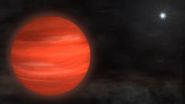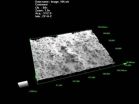(Press-News.org) COLUMBUS, Ohio – A study using a unique new instrument on the world's largest optical telescope has revealed the likely origins of especially bright supernovae that astronomers use as easy-to-spot "mile markers" to measure the expansion and acceleration of the universe.
In a paper to appear in the Astrophysical Journal, researchers describe observations of recent supernova 2011fe that they captured with the Large Binocular Telescope (LBT) using a tool created at Ohio State University: the Multi-Object Double Spectrograph (MODS).
MODS measures the frequencies and intensities of light shining from a star. Stars shine at different frequencies depending on the chemical elements they are made of; a star like the sun, which is made mostly of hydrogen, shines at different frequencies than a star that is made mostly of helium. So astronomers can use spectra to determine what a particular star is made of.
Based on the frequencies of light emanating from supernova 2011fe, this type of supernova – known as Type Ia – is most likely caused by the interaction between a pair of dead stars known as white dwarfs, the astronomers concluded. One white dwarf orbits the other and sheds material onto it, until the other white dwarf becomes unstable and explodes, shining billions of times brighter than the sun.
Astronomers worldwide have tried to confirm the origin of Type Ia supernovae for decades. Groups have proposed several different hypotheses, including exotic scenarios involving white dwarfs paired with still-"living" giant stars, or even stars like the sun.
Kris Stanek, professor of astronomy at Ohio State and a co-author of the study, explained why settling this issue is important.
"We really want to know more about these supernovae, given their importance in our understanding of how the universe is expanding," he said. "Many observations have been done over the years, and I think many astronomers are starting to accept one explanation – that two white dwarfs are probably responsible."
Still, the alternative theories keep re-emerging, he said: "like zombies that won't die."
"With this study, we were looking for a zombie 'kill shot,' and we think we found it."
Rick Pogge, professor of astronomy and lead designer of MODS, said that the spectrograph is the ideal tool for settling the debate.
"MODS is one of the most sensitive optical spectrometers in operation today, and being used on what is currently the world's largest optical telescope. If we couldn't kill this debate with MODS and the LBT, something would be dreadfully wrong," he added.
Type Ia supernovae make good mile markers for the universe because their extreme brightness – 5 billion times brighter than the sun – makes them easy to see, and their distinctive pattern of brightening and dimming in the weeks after they appear makes them easily identifiable.
Astronomers use that information to calculate the distance from Earth to the supernova, and in turn, calculate how fast the universe is expanding. Knowing more about the composition of the stars that create the supernovae could open up new ideas in the understanding of that expansion.
Here's what nearly all astronomers agree on: Type Ia supernovae originate in binary systems, where one star or star-like object is orbiting another. The main object – the one that initiates the explosion – is a white dwarf, the massive remnants of a dead star. Over time, the white dwarf's gravity peels off gas and dust from the companion and absorbs that material. Eventually, the white dwarf becomes unstable, and explodes in a supernova.
At issue, explained lead study author and doctoral student Ben Shappee, is the identity of the white dwarf's companion – is it another white dwarf, or a giant star, or even a star like our sun?
The Ohio State astronomers found their answer in the light spectrum emanating from the supernova. If the companion were a star like ours, or even a giant star, a sizeable portion of the debris blown away from the supernova would contain atoms of the element hydrogen.
Supernova 2011fe provided a good chance for the researchers to test for the presence of hydrogen. Located in the Pinwheel Galaxy some 21 million light-years away, it was the closest near-Earth Type Ia supernova to occur in the last 20 years.
"If the companion were a star such as ours or even a red giant, we would expect to see a lot of hydrogen in the signal – maybe even half a solar mass' worth, as the companion was blown away. But instead, we saw at most only one tenth of one percent of a solar mass' worth of hydrogen. That suggests that the white dwarf's companion had very little if any hydrogen in it, and is likely another white dwarf," Shappee said.
Pogge called the study "a beautiful demonstration of the kind of data we are able to get on a routine basis with the LBT and MODS. Our entire instrument team is very proud of how well MODS is working."
In fact, this study was done with only one half of the MODS system – MODS1 – which is currently installed on one mirror of the LBT. It's twin, MODS2, is currently under construction in Columbus and scheduled to be installed on the second mirror in early 2013.
###
Shappee pursued this work for his doctoral degree, with funding from a National Science Foundation (NSF) Graduate Research Fellowship. In keeping with the Department of Astronomy's tradition of training graduate students to defend their work through informal debate, he presented the paper at a "morning coffee" discussion, and posted a video explanation of the work on YouTube at http://go.osu.edu/P2g.
Coauthors on the paper also include Peter Garnavich from the University of Notre Dame. This research was supported by the NSF, and the MODS spectrographs are being built with funding from NSF along with additional funds from the Ohio Board of Regents and the Ohio State University Office of Research.
Contact: Ben Shappee, (614) 292-7881; Shappee.1@osu.edu
Krzysztof Stanek, (614) 292-3433; Stanek.32@osu.edu
Written by Pam Frost Gorder, (614) 292-9475; Gorder.1@osu.edu
Astronomers pin down origins of 'mile markers' for expansion of universe
2012-11-20
ELSE PRESS RELEASES FROM THIS DATE:
Smoking in pregnancy tied to lower reading scores
2012-11-20
Yale School of Medicine researchers have found that children born to mothers who smoked more than one pack per day during pregnancy struggled on tests designed to measure how accurately a child reads aloud and comprehends what they read.
The findings are published in the current issue of The Journal of Pediatrics.
Lead author Jeffrey Gruen, M.D., professor of pediatrics and genetics at Yale School of Medicine, and colleagues analyzed data from more than 5,000 children involved in the Avon Longitudinal Study of Parents and Children (ALSPAC), a large-scale study of ...
Astronomers directly image massive star's 'super-Jupiter'
2012-11-20
Astronomers using infrared data from the Subaru Telescope in Hawaii have discovered a "super-Jupiter" around the bright star Kappa Andromedae, which now holds the record for the most massive star known to host a directly imaged planet or lightweight brown dwarf companion.
Designated Kappa Andromedae b (Kappa And b, for short), the new object has a mass about 12.8 times greater than Jupiter's. This places it teetering on the dividing line that separates the most massive planets from the lowest-mass brown dwarfs. That ambiguity is one of the object's charms, say researchers, ...
Ah, that new car smell: NASA technology protects spacecraft from outgassed molecular contaminants
2012-11-20
Outgassing — the physical process that creates that oh-so-alluring new car smell — isn't healthy for humans and, as it turns out, not particularly wholesome for sensitive satellite instruments, either. But a team of NASA engineers has created a new way to protect those instruments from its ill effects.
For some people, the best part about buying a new car is its factory-fresh new car smell, a distinctive aroma created when the chemicals and residual solvents used to manufacture dashboards, car seats, carpeting and other vehicle appointments outgas and fill the cabin. ...
Some cells don't know when to stop
2012-11-20
Certain mutated cells keep trying to replicate their DNA — with disastrous results — even after medications rob them of the raw materials to do so, according to new research from USC.
New imaging techniques allowed scientists to see for the first time that while chemotherapy drugs shut down the DNA replication process of most cancer cells, so-called "checkpoint mutants" just keep chugging along, unwinding the DNA and creating damaged DNA strands that can result in the kind of abnormalities seen in cancer cells.
"Older methods suggested that these checkpoint mutants ...
NASA sees sun's 2 Prominence Eruptions
2012-11-20
VIDEO:
The Sun erupted with two prominence eruptions, one after the other over a four-hour period (Nov. 16, 2012). The action was captured in the 304 Angstrom wavelength of extreme ultraviolet...
Click here for more information.
The Sun erupted with two prominence eruptions, one after the other over a four-hour period on Nov. 16, 2012, between the hours of 1 and 5 a.m. EST. The red-glowing looped material is plasma, a hot gas made of electrically charged hydrogen and helium. ...
Beargrass, a plant of many roles, is focus of new report
2012-11-20
Beargrass is an ecologically, culturally, and economically important plant in the Western United States and, for the first time, landowners, managers, and harvesters now have a comprehensive report about the species.
The report, Natural and Cultural History of Beargrass (Xerophyllum tenax), published by the U.S. Forest Service's Pacific Northwest Research Station, identifies critical knowledge gaps and areas for future research. It also documents how changes in disturbance, including fire, may affect the species across its range.
"Beargrass is emblematic of a web of ...
Estrogenic plants linked to altered hormones, possible behavior changes in monkeys
2012-11-20
Berkeley — Eating certain veggies not only supplies key nutrients, it may also influence hormone levels and behaviors such as aggression and sexual activity, says a new study led by researchers at the University of California, Berkeley, that could shed light on the role of diet in human evolution.
The research is the first to observe the connection between plant-based estrogenic compounds, or phytoestrogens, and behavior in wild primates — in this case, a group of red colobus monkeys in Uganda.
The more the male monkeys dined on the leaves of Millettia dura, a tropical ...
Adolescents with low status among peers are more likely to become adult smokers
2012-11-20
A new study from Sweden reveals that having low peer status in adolescence is a strong risk factor for regular and heavy smoking in adulthood.
Researchers from Stockholm University in Sweden used a large database that followed the lives of more than 15,000 Swedes, mainly from the Stockholm area, from birth to middle age. The researchers isolated 2,329 people who were interviewed once at age 13 about peer status at school and again at age 32 about their smoking habits. The results indicate that the lower a young person's status is among his or her school peers, the more ...
Novel breast screening technology increases diagnostic accuracy
2012-11-20
OAK BROOK, Ill. – The addition of three-dimensional breast imaging—a technology called tomosynthesis—to standard digital mammography significantly increases radiologists' diagnostic accuracy while reducing false positive recall rates, according to the results of a multi-center study published in Radiology.
"This is the first major advance in breast imaging and breast cancer screening since the development of breast MRI," said lead researcher Elizabeth A. Rafferty, M.D., director of Breast Imaging at the Avon Comprehensive Breast Center at Massachusetts General Hospital ...
New coronavirus related to viruses from bats
2012-11-20
The virus that is causing alarm among global public health authorities after it killed a man in Jeddah, Saudi Arabia earlier this year and is now linked to two other cases of disease is a novel type of coronavirus most closely related to viruses found in bats, according to a genetic analysis to be published in mBio®, the online open-access journal of the American Society for Microbiology, on November 20. Researchers studied the genome of the HCoV-EMC/2012 virus in detail to learn about its relatedness to other viruses and about possible sources. The results of the sequencing ...


